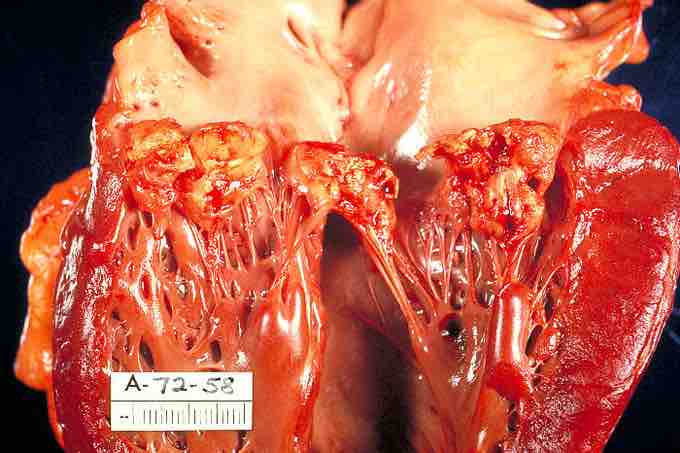Both the cardiovascular system and the lymphatic system are susceptible to diseases caused by microorganisms.
In the cardiovascular system, the heart, the blood vessels (arteries, capillaries, and veins), and the blood are targets of pathogens. Two common cardiovascular diseases caused by infection with microorganisms are endocarditis and myocarditis.
- Endocarditis is inflammation of the inner tissue of the heart such as its valves caused by infectious agents . The agents are usually bacterial, but other organisms can also be responsible. Since, the valves of the heart do not receive any dedicated blood supply, the defensive immune mechanisms (such as white blood cells) cannot directly reach the valves via the bloodstream. The lack of blood supply to the valves also has implications for treatment, since drugs also have difficulty reaching the infected valve.
- Myocarditis or inflammatory cardiomyopathy is inflammation of heart muscle (myocardium) and it is most often due to infection by common viruses, such as parvovirus B19. It is often caused by an autoimmune reaction. Streptococcal M protein and coxsackievirus B have regions (epitopes) that are immunologically similar to cardiac myosin. During and after the viral infection, the immune system may attack cardiac myosin. Because a definitive diagnosis requires a heart biopsy, which doctors are reluctant to do because they are invasive, statistics on the incidence of myocarditis vary widely. The consequences of myocarditis thus also vary widely. It can cause a mild disease without any symptoms that resolves itself, or it may cause chest pain, heart failure, or sudden death. As most viral infections cannot be treated with directed therapy, symptomatic treatment is the only form of therapy for those forms of myocarditis. In the acute phase, supportive therapy, including bed rest, is indicated. For symptomatic patients, digoxin and diuretics provide clinical improvement.
Bacteremia is the presence of bacteria in the blood. Bacteria can enter the bloodstream as a severe complication of infections (like pneumonia or meningitis), during surgery (especially when involving mucous membranes such as the gastrointestinal tract), or due to catheters and other foreign bodies entering the arteries or veins (including intravenous drug abuse). Bacteremia can have several consequences. The immune response to the bacteria can cause sepsis and septic shock, which has a relatively high mortality rate. Bacteria can also use the blood to spread to other parts of the body (which is called hematogenous spread), causing infections away from the original site of infection. Examples include endocarditis or osteomyelitis. Treatment is with antibiotics, and prevention with antibiotic prophylaxis can be given in situations where problems are to be expected.
Vasculitis is inflammation of the vessel wall due to an infection (or autoimmune disease). Blood vessel permeability is increased in inflammation. Damage, due to trauma or spontaneously, may lead to hemorrhage due to mechanical damage to the vessel endothelium.
Lymphatic disease is a class of disorders that directly affect the components of the lymphatic system. Lymphadenopathy is a term meaning disease of the lymph nodes due to infection, auto-immune disease, or malignancy. Enlarged lymph nodes are a common symptom in a number of infectious diseases, of which some are as follows:
- Acute infection (e.g., bacterial, or viral), or chronic infections (tuberculous lymphadenitis, cat-scratch disease).
- The most distinctive symptom of bubonic plague is extreme swelling of one or more lymph nodes that bulge out of the skin as "buboes. " The buboes often become necrotic and may even rupture.
- Infectious mononucleosis is an acute viral infection, the hallmark of which is marked enlargement of the cervical lymph nodes.
- It is also a symptom of cutaneous anthrax, measles and Human African trypanosomiasis, the latter two giving lymphadenopathy in lymph nodes in the neck.
- Toxoplasmosis, a parasitic disease, gives a generalized lymphadenopathy.

Endocarditis
A mitral valve vegetation caused by bacterial endocarditis.